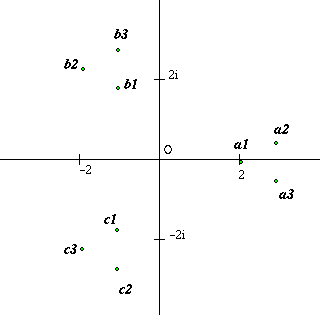Cube roots
Problem
Evaluate without a calculator:
$(5\sqrt 2 + 7)^{{1\over 3}} - (5\sqrt 2 - 7)^{{1\over 3}}.$
Getting Started
$c-d$ is a factor of $c^3 - d^3$.
Student Solutions
Looking first for real roots, note that
$ (5\sqrt{2}+7)(5\sqrt{2}-7) = 50-49 = 1 $ so $c^3d^3=1 $ and hence $cd=1$ .Also
So
$c-d$ satisfies $x^3+3x-14=0,$ and this has only one real root $x=2$ . \[ x^3+3x-14 = (x-2)(x^2+2x+7) = 0 \] . $x^2+2x+7=0$ has complex roots $-1+i\sqrt{6}$ and $-1-i\sqrt{6}$ .Hence
$x=c-d=2$ is the only real value of the given expression.There will be altogether 9 complex values of
Image

|
$(5\sqrt{2}+7)^\frac{1}{3} - (5\sqrt{2} -
7)^{\frac{1}{3}}$ $\begin{eqnarray} b_1& =& 2\omega \\ b_2& =& (-1-i\sqrt{6})\omega^2 \\ b_3 & = & (-1+i\sqrt{6}) \\ c_1& = & 2\omega^2 \\ c_2 & = & (-1-i\sqrt{6}) \\ c_3 & = & (-1+i\sqrt{6}) \end{eqnarray}$ |
Neil
of Madras College found the
complex values and dicovered some beautiful patterns when he
plotted them in the complex plane. Neil's discoveries can be
generalised to a 1/3
- b 1/3
for any real or complex numbers a and b,
and from cube roots to n th
. roots.
In order to find patterns similar to the ones discovered by Neil, but in a simpler situation, and to see how his ideas can be generalised, you may like to plot the twelve values of 8 1/3 + 81 1/4 in the complex plane.
Teachers' Resources
Why do this problem?
It provides experience of using algebra and working with surds. It leads into complex cube roots if you want to explore the patterns arising with those solutions.Key questions
We have to evaluate$c^{1\over 3} - d^{1\over 3}$ what are $c^3$, $d^3$, $cd$ and $(c-d)^3$?
